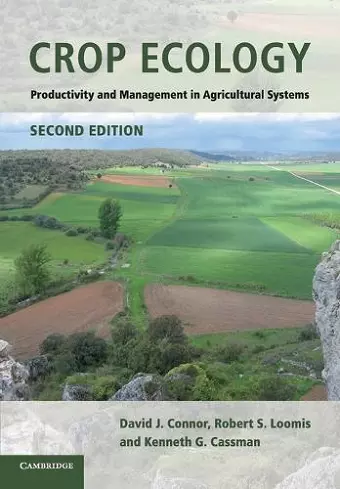Crop Ecology
Productivity and Management in Agricultural Systems
David J Connor author Robert S Loomis author Kenneth G Cassman author
Format:Paperback
Publisher:Cambridge University Press
Published:28th Apr '11
Currently unavailable, and unfortunately no date known when it will be back
This paperback is available in another edition too:
- Hardback£150.00(9780521761277)

A detailed exploration of the impact of environmental conditions and management on crops, resource requirements and soil resources.
An updated and thoroughly revised second edition providing in-depth coverage of the impact of environmental conditions and management on crops, resource requirements for productivity and effects on soil resources. The approach is explanatory and integrative, with a firm basis in environmental physics, soils, physiology and morphology.Food security and environmental conservation are two of the greatest challenges facing the world today. It is predicted that food production must increase by at least 70% before 2050 to support continued population growth, though the size of the world's agricultural area will remain essentially unchanged. This updated and thoroughly revised second edition provides in-depth coverage of the impact of environmental conditions and management on crops, resource requirements for productivity and effects on soil resources. The approach is explanatory and integrative, with a firm basis in environmental physics, soils, physiology and morphology. System concepts are explored in detail throughout the book, giving emphasis to quantitative approaches, management strategies and tactics employed by farmers, and associated environmental issues. Drawing on key examples and highlighting the role of science, technology and economic conditions in determining management strategies, this book is suitable for agriculturalists, ecologists and environmental scientists.
'The new edition of Crop Ecology, by Connor, Loomis, and Cassman, retains the strengths of the earlier edition, namely, insightful analysis of the key principles that explain crop resource use and growth, based on extensive use of peer-reviewed data, averaging more than one graph or table per page. Any practitioner or student of 'evidence-based agriculture' needs a copy of this book.' R. Ford Denison, University of Minnesota, and author of Darwinian Agriculture
'… a timely update of a foundational text for college or graduate curricula providing comprehensive treatment of ecological principles and concepts central to achieving global food security and to conducting the environmental accounting critical to sustaining productivity through judicious natural resource management … an essential desk reference for practising systems agronomists, agro-ecologists, and agricultural economists and biological engineers pursuing biophysical life cycle analyses. With a predominant focus on staple crop systems, [the] authors … present key biophysical mechanisms and processes with detailed explanations of the quantitative approaches to their estimation; in-depth examples and case studies facilitate comprehension. Important new sections include ideotype concepts in respiration and partitioning, spatial variability in soil management, energy and labor requirements for bioenergy crops, and irrigation and world food supply. This book is remarkably easy to read and will be accessible to a range of knowledge levels and backgrounds.' Sylvie M. Brouder, Purdue University
'… a good introductory text for students of agriculture and environmental science.' The Biologist
'The second edition provides a worthy successor to the first. … It is easy to read despite containing a wealth of detail. It is definitely a book to recommend to serious students of crop science and of managed ecosystems.' Journal of Agricultural Science
'This edition retains the engaging conversational tone that made the original volume popular with students. The presentation of crop ecology in this text employs unparalleled clarity to facilitate interest and learning. Despite its focus as an educational work, this book would have considerable utility as a reference for practitioners in the field. As with the original text, the second edition saves the best for last - Chapter 18 conveys the authors' collective vision for the future of agriculture. If this edition weathers the test of time as well as [the] original, then this chapter alone is required reading for agriculturalists.' Thomas G. Chastain, The Quarterly Review of Biology
ISBN: 9780521744034
Dimensions: 244mm x 173mm x 25mm
Weight: 1110g
576 pages
2nd Revised edition